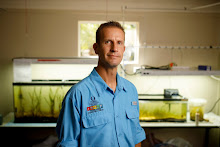
Folks who know I'm a marine biologist often ask me if I can recommend any good, nearby snorkeling spots. (Within the Naples / Bonita Springs / Estero / Fort Myers / Sanibel area.) The answer is YES I CAN- SORT OF.
The thing is, this part of Florida doesn't have any near-shore coral reefs, and the waters are often dark and murky from a combination of natural and man-made factors like stirred-up mud, tannins, and blooms of microscopic algae that feed off the high levels of nutrients in the water. So even where there IS cool underwater life to see, you often can't see it very well because of the poor water clarity. Having given those disclaimers to set expectations appropriately low, I have had some good snorkeling experiences around here, and I'll tell you where your best bets are to have some good experiences yourself.
General recommendations-
1. Best times are weekday mornings before there is much boat traffic to stir up the water. Boats can also run over you and chop you into little giblets of meat with their propellers. So you should bring a dive flag if you're going in an area that potentially has powerboats.
2. Best times are when it hasn't been too windy / wavy, because wind makes waves and waves stir up mud from the bottom that reduces the visibility. Winds less than 10 knots are usually OK. That said, you can get away with snorkeling when it's windier if the winds are OFFSHORE WINDS. That means winds blowing from the land out to sea. These will not make waves along the shoreline, so they won't stir up the water.
3. Tide (level and whether it's coming in or going out) matters. Particularly when you're near the mouth of the estuary, where there's a changing mix of fresher estuary water and saltier ocean water, you may get the best water clarity when the tide is coming in, bringing the more clear water from offshore in the Gulf of Mexico. However, if there have recently been a lot of waves in the Gulf of Mexico from West winds, the incoming tide won't help and it could actually be more clear further back into the estuary. Tide can also matter because some sites may be too shallow at low tide or too deep at high tide.
Specific sites-
Estero Bay- Estero Bay is a shallow, semi-enclosed body of water where fresh and salt water mix. It has some interesting sea bottom habitats including beds of seagrass and seaweed that often have snails, fish, sea urchins, anemones, crabs, and other organisms living in them. The trick is to find a seagrass bed accessible from shore, in an area where the water isn't too murky. I have had some luck going from the east side of the road at Bonita Beach Dog Park on Lovers Key.There's a shallow area with seagrass, and a deeper channel as you go south towards the New Pass bridge that has some oysters and other shells and often has interesting crabs, urchins, and fish like Mangrove Snappers and Sheepshead.
A sand perch hanging out by a clump of oyster shells in the deeper channel part.

Another site at Estero Bay that sometimes works is the Big Carlos Pass beach access at the north end of Lovers Key. Big Carlos Pass is the biggest opening from Estero Bay into the Gulf of Mexico, and it sometimes has pretty clear water on an incoming tide. The bottom there is shelly, and there are some big pieces of rubble further out, like concrete pipes, that are covered with sponges, seaweed, and sometimes soft corals. Underneath the Big Carlos Pass bridge, around the pilings, there are piles of concrete blocks that often have reef fishes swimming around them. Just watch out for fishing lines and boats.
The ocean side of Lovers Key can also work for brave snorkelers if the tide is slack or outgoing and there are no waves. Near the entrance to Big Carlos Pass there is kind of a deep channel between shore and an offshore sandbar, and the sand is scoured away from the bottom there revealing rocks with urchins, seaweed, and sometimes big fish. You can swim really far out from shore and still in be in shallow water over the shifting sandbars. Watch out for boats, though.
San Carlos Bay- San Carlos Bay is the crossroads of several estuaries in the more northern part of Lee County. It's where the Caloosahatchee Estuary meets Matlacha Pass and Pine Island Sound. The toll bridge to Sanibel Island (the Sanibel Causeway) crosses San Carlos Bay and includes two man-made islands where you can pull off and park to snorkel or windsurf or picnic or whatever. Look at the area on Google Earth and pick a spot where you see dark, mottled patches near shore. Those are seagrass and seaweed beds with a mixed shelly / sandy bottom. Depending on which direction the wind is coming from, different sides of the different causeway islands may offer the best shelter from the wind and waves and the most clear water.
If you want to snorkel in a similar environment but don't want to pay the $7 toll for the Sanibel Causeway, you can pull off on the side of the road just before the causeway at San Carlos Bay beach.
Another interesting spot is Bunche Beach, which has a mix of seagrass, seaweed, sand, rock/shell and invertebrates like sponges.
Good luck exploring, and if you make any great snorkeling discoveries, please share them in the comments.
